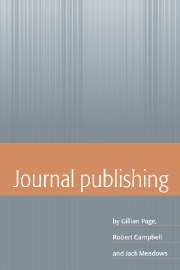Book contents
- Frontmatter
- Contents
- List of figures
- List of tables
- Preface
- 1 Introduction to journals
- 2 Editing
- 3 Production
- 4 Marketing
- 5 Subscription management and distribution
- 6 Non-subscription revenue
- 7 Legal and ethical aspects
- 8 Financial aspects
- 9 Bibliographic aspects
- 10 Managing a list of journals
- 11 Electronic publishing
- Appendix 1 Getting tenders for journals
- Appendix 2 Publishers' and editors' associations
- Glossary
- Bibliography
- Index
2 - Editing
Published online by Cambridge University Press: 23 October 2009
- Frontmatter
- Contents
- List of figures
- List of tables
- Preface
- 1 Introduction to journals
- 2 Editing
- 3 Production
- 4 Marketing
- 5 Subscription management and distribution
- 6 Non-subscription revenue
- 7 Legal and ethical aspects
- 8 Financial aspects
- 9 Bibliographic aspects
- 10 Managing a list of journals
- 11 Electronic publishing
- Appendix 1 Getting tenders for journals
- Appendix 2 Publishers' and editors' associations
- Glossary
- Bibliography
- Index
Summary
Introduction
Editors are responsible for the selection and preparation of material for publication. There are at least five distinct editorial tasks in journal publishing though often one person will perform several. Firstly, there is the person within the publishing organisation who has responsibility for acquiring and developing journals: the ‘publisher's editor’. Secondly, there is the editor of an individual journal, concerned primarily with its content as a whole: the journal editor. Journal editors may have the support an assistance of associate, assistant or regional editors, or editors for particular topics or sections. Fourth, the copy-editor, sub-editor or desk-editor (sometimes ‘redactor’) sees that the material to be published is presented as well as possible, and that the copy can be followed easily by the typesetter. Then there may be a ‘managing editor’ or ‘production editor’ looking after the flow of typescripts and proofs; that job may be done by a person specially designated, or by any of the other editors, or their staff. This chapter considers the role of each. A managing editor may have other responsibilities, for instance for business management and liaison with colleagues responsible for non-subscription revenue; these are discussed in other chapters. There is inevitably some overlap with chapter 10 on the management of a list of journals.
The publisher's editor
Within a larger publishing house there will be several grades of editor. The editor-in-chief, or editorial director, is responsible for formulating editorial policy and often for acquiring books, journals and electronic publications in a particular area.
- Type
- Chapter
- Information
- Journal Publishing , pp. 33 - 64Publisher: Cambridge University PressPrint publication year: 1997



